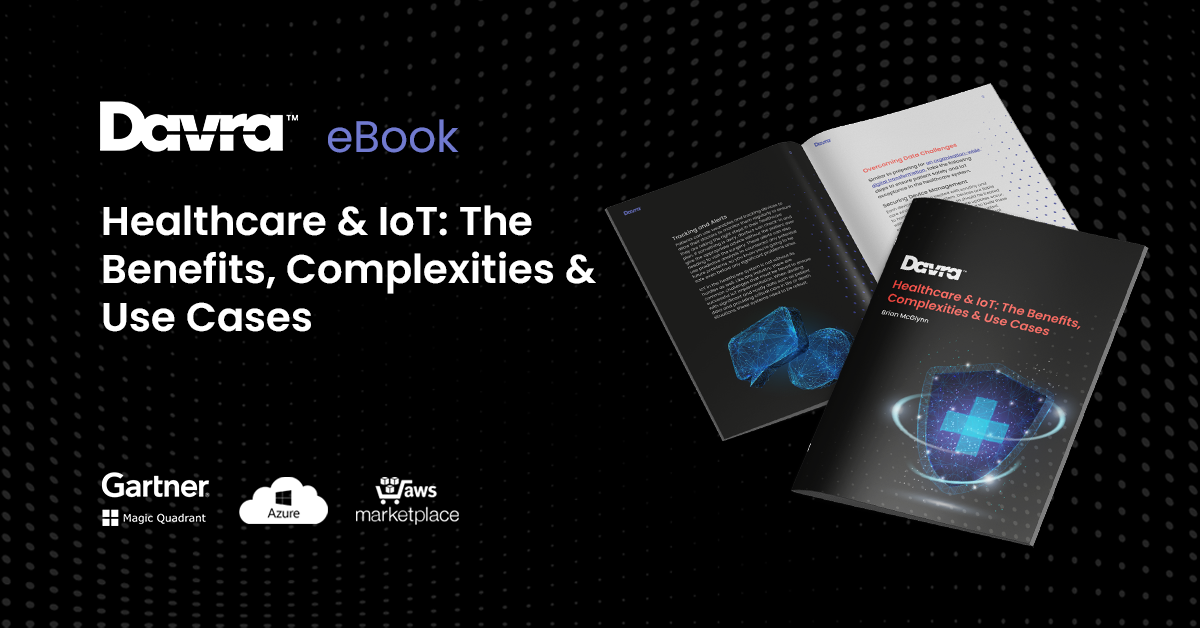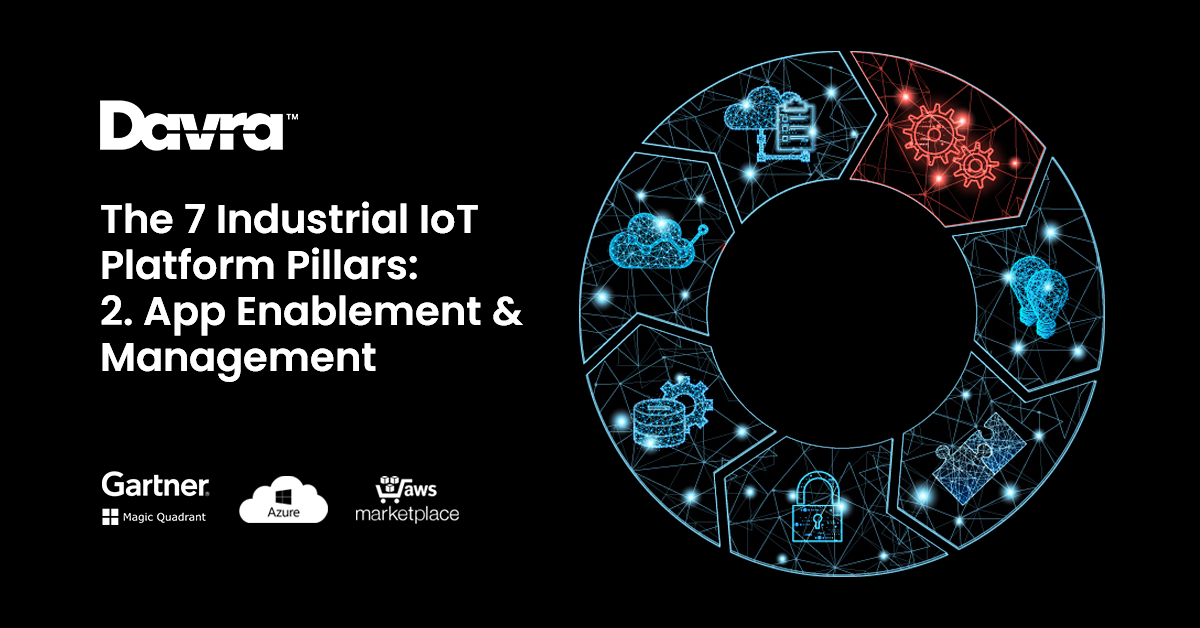IoT in Healthcare Use Cases eBook
Download Your Free IoT in Healthcare Use Cases eBook
Read More


Next in our 7 IIoT Platform Pillars is Application Enablement & Management. This is another critical component to any IIoT network as it provides part of the outward-facing software that team members and staff utilise in their day to day work. If you want to catch up with the previous pillar before reading on, you can find it here.
In this blog post pillar, we’ll discuss what exactly Application Enablement & Management is, its benefits and the processes we go through on the Davra platform to build out an application that can be utilised across multiple industries.
Having been voted as the leading True-Born Industrial IoT Platform on Gartner’s Magic Quadrant in 2019, we will pull Gartner’s definition of what application enablement and management is:
“This function includes software that enables business applications in any deployment model to analyze data and accomplish IoT-related business functions. Core software components manage the OS, standard input and output or file systems to enable other software components of the platform. The application platform (for example, application platform as a service [aPaaS]) includes application-enabling infrastructure components, application development, runtime management and digital twins. The platform allows users to achieve “cloud scale” scalability and reliability and deploy and deliver IoT solutions quickly and seamlessly.”
We like to look at building applications like an iceberg; 20% of the apps are built by you to add value and ease to your system workflows, but the other 80% is our Davra IoT platform underneath, these building blocks such as analytics, rules engines, edge device management and many more translates into applications. We have a layer that has API developer tools that call into these building blocks, use them as the ingredients of the application in order to produce fully fledged enterprise apps that can scale, are robust and are secure.
These below-the-water horizontal, reusable building blocks are developed with IoT solutions in mind, they are matured end user applications that can be pulled across many industries.
Many of our customers have implemented the platform for connected industrial assets, as our platform’s integration capabilities and ease of use for application enablement and administration are well established and integral to our company.
In a previous blog post we spoke about the benefits of working with an IoT Application Enablement Platform, but it’s also important to fully assess each of the client requirements to ensure the correct applications and protocols are being developed relative to the industry they’re in.
We look at the level of effort that makes sense and at what point, when dealing with the customer. IoT is a top of the funnel heavy market, meaning a lot of people want various proofs of concept. A solid strategy, along with low risks and costs is advisable as we’re not trying to invent the wheel.
Depending on the level of customisation needed, we can take multiple application development approaches:
• No code approach
• Low code: slightly tweak things
• High code: completely customised applications.
On the Davra platform, there’s a full vertical offering. Multiple point solutions can be delivered into the same vertical; there’s a catalog so customers have a bundle of solutions they can purchase as it’s a mix and match.
Davra takes the best in class components; open source, Cassandra, MongoDB, Kafka and fine tunes them with IoT in mind. Doing this research takes the pressure off our customers about choosing what would best suit them. Figuring out what component is best in class for any job under the hood, be it storing data, scale, big data, performing analytics, those components are in the platform.
We also pay the maintenance overhead tax so our developers don’t have to, which ensures maximum security.
We can build out of the box services on the platform if we see that a component can be made somewhat generic. Then in the future if someone wants to build an app similar to that, they can just consume the module out of the box. Over the years implementing IoT solutions, the platform has evolved outwards to deliver more out of the box, so customers can get to the market faster and know it’s a trusted proof of concept.
There is a commercialisation layer on the Davra site that provides a professional services arm and payments solution. We have more developers outside of Davra developing apps on our platform so this payments layer enables governance on our platform.
The Davra platform is licensed to others to build apps so we’ve built billing into our platform, hence why we have an under the hood Stripe system set up. We have an out of the box payment plan for customers which links to Stripe and plan ids. If your customers buy something off you that needs more resources to be unlocked from Davra to you, your app developers can come up with their own commercial model on the platform.
The applications are highly customisable with widgets, as well as providing keys to decide who can view or edit, delete the apps so not just anyone has access. By default the apps have Davra branding, but you can edit all apps with your own logos.
We have an out of the box catalog so you can pick whatever widgets you wish for your application pages. KPIs and also custom components if you need something very specific for data visualisation, for example fleet-focused widgets.
The Platform also has support for sensor data as well as video and audio data to give context around what is happening in any given environment. Hierarchies can be created in plants to drill into the plant floor, then onto the line, then drill into individual machines.
In car parking applications, LoRa sensors model the levels and see how many spaces are available in the car park.
Fleet applications use sensors in the container to see what route it took, and drill down to the GPS on the vehicle, even if it’s multi-modal; truck, train, rail and ship. An issue can then be pinpointed on the journey to see where the threshold was breached.
The Davra Platform also enables application building that manages the entire network; management of the underlying network and the devices that make up the IoT. If the network, devices and the infrastructure that makes up the IoT solution is not performing optimally it undermines the infrastructure.
Applications and workflows can also drill down to individuals in their home environment; people who need to be monitored for health reasons and don’t have full-time care assistance. They can be monitored using a smart watch, installing environmental sensors in the home; when the doors may open and close. This raw data might not tell us a whole lot, but when you go into behavioural analytics and perform statistical analysis on the data, it can produce a number that tells us whether this person is following a normal routine; how often they stay in bed or go to the toilet for example.
This can then cater for incident response workflows so someone can respond to that data. Audit trails and history are logged to manage liability or chain of custody. It’s imperative to have high integrity of what happened in response to the event.
Applications are also developed with easy to use graphical user interfaces and workflows for people who may not be technical. For example in train transport; public announcement systems, ad hoc scheduling through both audio and visual channels to make these announcements can be deployed.
An example of our platform being utilised in multiple ways is with San Diego MTS. Davra has installed computers and GPS on each of the trains and has an algorithm working in the background so it knows all the stops on the tram line. This finely tuned algorithm knows with 10-20 second accuracy what time the train will stop at each point. You can zoom in on each of the trains to see which direction it’s going in, along with the diagnostic information to see how the equipment on that train is performing so the MTS team can troubleshoot the tram if anything happens while it’s operating. The maintenance team can login remotely to each train and diagnose the situation to get it back up and running again.
A strategy by one organisation can put the platform in place, deliver the first solution in order to deliver a second solution on the same platform. This reduces costs as opposed to buying another siloed application and then the two apps cannot talk to each other.
This benefit pertaining to Davra means customers can increase their efficiencies through building multiple apps on the same platform.
The Davra platform also caters to custom microservices. We manage, develop and maintain the lifecycle of your code to ensure consistency across your IoT devices and platform.
It is taken in through Git and then built in Jenkins.
The rules engine taps into the data as it flows through the system to look at the data as it goes by and runs rules against it. A large number of use cases can be delivered but there is always business logic that neither of those two facets of the platform will deliver on, which is where custom microservices come in.
1. Custom API
Simple HTTP endpoint: a widget that the framework makes a call to and gets back and gets a result.
2. Rules Engine
Rules invoke business logic inside the microservice.
3. ETA algorithm
An algorithm running that taps in live into the data flow.
4. Single Page Apps or Microservice Apps
Perhaps the client needs a certain user experience that needs to take full control over the screen presented to the user.
With this platform you’re not confined to running Javascript, can run Python, C++ in Java. It doesn’t matter what code it is written in as the docker file enables the interface between the two.
The difference between running in the terminal and in production is Davra owns the lifecycle of this code, if there’s a bug in the code and it crashes, we will bring it back up again and keep it live.
With the Davra platform, our application knowledge spans multiple industries and verticals so you don’t have to figure out the complexities relating to your system because chances are we’ve already done the work. Our next pillar will be focusing on digital twins and how you can replicate and simulate your physical assets in a virtual environment. If you have any questions about Application Enablement & Management, or how you could develop a platform for your organisational systems, please get in touch with us today.
Brian McGlynn, Davra, COO
Download Your Free IoT in Healthcare Use Cases eBook

Davra IoT is the only Industrial IoT Platform Available on AWS Marketplace
Read MoreThe Collaboration of Humans & Robots Has Created The Cobot
Read More